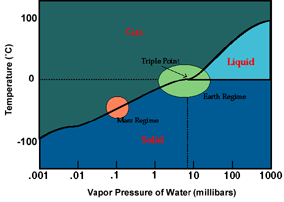









  


|
Volatiles: Substances Subject to Change

The goals of the MVACS payload, as its name suggests, are to study volatiles and climate on Mars. But
what are volatiles? From a purely physical point of view, planets can be thought of as large, self-contained
collections of atoms and molecules. The laws of chemistry and physics operating through time have
sorted these substances into their present forms and locations. For example, on Mars, substances with
high freezing points are solid, like basaltic rock on the planet's surface and interior. Substances with low
freezing points are vapor, like argon gas in Mars' atmosphere. But if a substance has a freezing point that
lies within the range of daily or seasonal extremes of temperature, it will change form, or phase, over
time. On Mars, water and carbon dioxide fall into this category and technically are called volatiles. The
very fact that volatiles are affected by changes in daily, seasonal, and climatic changes in temperature
make them extremely interesting to monitor.
 Shown above is the phase diagram for water (click on the image for a larger version). The pressure and temperature ranges for both Earth (light green) and Mars (orange) are shown on the diagram. Note that all three phases of water (gas, liquid, solid) can be found on the surface of Earth. Under today's conditions, water can be present on Mars only as a solid or a gas.
Shown above is the phase diagram for water (click on the image for a larger version). The pressure and temperature ranges for both Earth (light green) and Mars (orange) are shown on the diagram. Note that all three phases of water (gas, liquid, solid) can be found on the surface of Earth. Under today's conditions, water can be present on Mars only as a solid or a gas.
|

